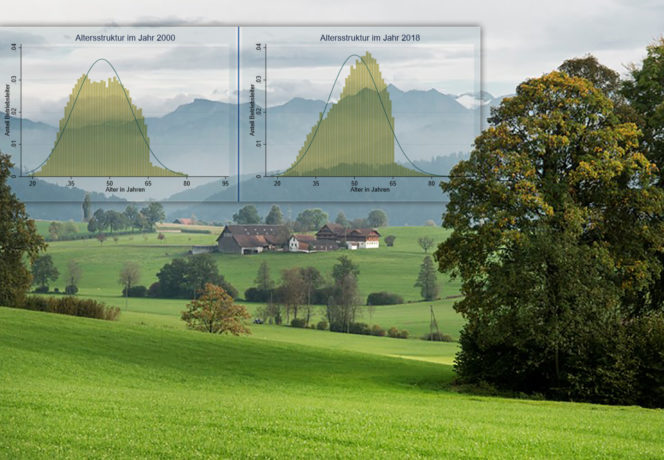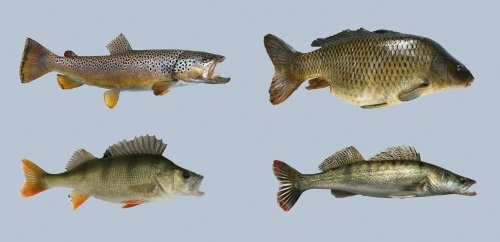
Archive
343 posts

Farmers are increasingly required to communicate electronically with the authorities. This is obligatory regarding the management of direct payments and the livestock census. Agroscope interviewed farmers on their perception of the administrative workload.

Digital Technologies in Agricultural Training
Digitalisation is playing an increasingly important role in agriculture. What knowledge is imparted in the Farm Manager course? An online survey shows where there is a need for expansion.

Income in Agriculture: a Holistic Analysis is Needed
Farms, their risks and various underlying conditions are becoming increasingly complex. Because of this, agricultural income should be considered holistically.

Scenarios for Agricultural Policy in the Age of Digitalisation
How is digitalisation changing agriculture and agricultural policy? A European team with the participation of Agroscope, the FOAG and the ETH developed four scenarios from which strategies were derived for the future achievement of agricultural policy goals.

Better Milk Price and Low Basic Ration Costs Make Grass-Fed Milk Cost-Efficient
Grass-fed milk production meets a customer need, and is linked to specific feed and animal-welfare requirements. An Agroscope study sought to determine the circumstances in which grass-fed milk production is worthwhile.

Increasing Food-Security Challenges Faced by Switzerland
Agroscope conducts an annual analysis of the risks to food supply on behalf of the Swiss Federal Office for Economic Supply FONES. In 2021, a power shortage, seed imports and climate change were addressed as particular risks.

How Dairy Farmers Improve Their Quality of Life
Dairy farmers have developed individual strategies designed to maintain or improve their quality of life. A project by BFH-HAFL collected and analysed a variety of those strategies.

Emergency Supplies Before, During and After the Swiss Confederation’s COVID-19 Measures
The older the respondents, the better they know and follow the emergency supply recommendations. Experience from the first lockdown can help ensure more stocking-up in future.

Tackling Farm Succession Holistically and at an Early Stage
In the coming years, farm succession will become a topical issue for many Swiss farming families. However, the process is demanding. A research and development project at BFH-HAFL highlights challenges and presents tools

Swiss Dairy Farms – Economic Performance Potential and Limits
In order to increase the competitiveness of Swiss milk production, the performance of the farms must be improved. Agroscope shows that the majority of producers work efficiently, but that the differences in productivity are great.

Swiss Farms: Ever-Increasing Size and Specialisation
The number of farms with a minimum area of 30 ha is growing, and specialisation – particularly in animal production – is on the increase. Even so, structural change is proceeding at a slower pace in Switzerland than in neighbouring countries.

Direct marketing is widespread among organic farms in the Canton of Bern
Direct marketing in the agricultural sector is becoming increasingly important in Switzerland. Between 2010 and 2016, this business sector recorded an increase of 60 % across Switzerland, measured as the number of farms adopting this form of marketing. A cross-sectional comparison of the Canton of Bern was used to investigate the extent to which the…

How do the cantons support their agricultural sector?
With an agricultural policy that is largely shaped by the Confederation, Switzerland’s federalist structures are only marginally noticeable. Even so, depending on their location, farms can take part in certain cantonal programmes whilst making use of the direct-payment instruments of the Confederation. With the aim of promoting and steering regional agriculture according to local needs,…

Social learning: videos put across success factors for marketing regional products
As part of a «by farmers to farmers» project, authentic films have been produced and used in the networks in collaboration with a support group from research, administration and practice. In making these films, the «social learning video» method was applied. The purpose of these films is to motivate farmers to implement new regional marketing…

Communal alpine pastures: between commons and incentive
Communal alpine pastures are a popular subject for the study of collective economic activity, despite the fact that there is very little empirical material available on which to base this study. In order to create a broader empirical foundation, five alpine pastures were visited whose organisation and economic processes were tracked by means of participatory…

Highlighting and planning workload on the farm and in the family
More and more farm-manager couples plan and discuss everyday tasks on the farm and for the family jointly, in order to achieve greater flexibility in accomplishing their work. The available planning tools and work budgets for work on the farm and in the household are, however, based on different data sources. In some cases, data…

What factors influence the perception of administrative work?
When it comes to developing recommendations for action for limiting administrative work, knowledge about both the perception of work and the actual work is important. This topic was investigated using the example of the Programme for the Promotion of Grassland-Based Milk and Meat Production (GMMP). A survey of 892 farmers revealed that the perception of…

The fall and rise of Swiss Braunvieh Breeding
Just 20 years ago, over half of the genetic material for the breeding of Braunvieh cattle was imported – primarily from North America – despite the fact that Switzerland is the genetic centre for Braunvieh. Today, however, the self-sufficiency level for Braunvieh breeding material is just shy of 100 %, and Switzerland has even become…

Profitability of para-agricultural activities
Using cost/performance calculations, the profitability of four para-agricultural activities (contracted work for third parties, direct marketing, tourism and services) is investigated, with labour utilisation, i.e. the resultant hourly wage, serving as a criterion. With a focus on farm activities with a gross performance of between CHF 10,000 and CHF 100,000, there are 2339 observations available…

Market analysis of the Swiss fish value chain
In 2016, 75,791 metric tons of fish and seafood were sold in Switzerland, 1,679 metric tons of which were domestically produced. Per capita consumption stood at 9.1 kg and had increased by approximately 60% over the 25 years prior. The present market analysis of the Swiss fish value chain describes the status quo of the…

Food security payments: refining objectives and using resources more efficiently
Since 2014, the Swiss Confederation has made food-supply security payments to ensure the reliable supply of food to the population. At CHF 1.1 billion per annum, these account for a large proportion of direct payments. Agroscope has now tested the effectiveness of this instrument on behalf of the Federal Office for Agriculture, and is proposing…

Implications of herbicide-free Extenso wheat cultivation in Switzerland
Various stakeholders are searching for ways to reduce herbicide use on farms. The implications of such measures, however, are often unknown. This article makes use of a bio-economic model to analyse how plant-protection strategies, yields and contribution margins change in Swiss Extenso winter-wheat cultivation if i) neither glyphosate and ii) nor other herbicides are used.…

Swiss private-label branded beef: brand credibility and consumer trust
Ethologically and ecologically sound production methods, brand awareness and brand credibility are all preconditions for the production of high-quality beef and veal. The market research results presented here show that certain consumer segments more frequently consume Swiss private label branded beef if high production standards in terms of animal welfare, ecology and pasture grazing are…

We are what we eat: the market potential of ethnic foods
When people migrate from other cultures to Switzerland, they bring their preferences for the food of their countries of origin. We are what we eat! This article explores the systematic relationship between immigration and food imports for various product categories. The results show that food imports in almost all product categories rise most strongly with…

Milk production: fresh grass with low concentrates pays off
Many Swiss dairy farmers use variable proportions of fresh grass (forage or grazing) and supplementary feed in their production. Which characteristics are economically successful in these fresh grass systems? This question was addressed in the project «Optimisation of grassland- based milk production systems based on forage (Hohenrain II)» conducted on 36 pilot farms over three…

Analysis of value distribution in the dairy sector
The price of milk delivered to industry by dairy farmers has been steadily decreasing over the last 10 years. In response to this situation, a study on «value distribution in the Swiss agro-food supply chains» has analyzed the situation and suggests concrete measures to improve the financial return to farmers. Across all agricultural sectors, prices…

Profitability of different production orientations in the mountain region
The profitability of mountain agriculture is of particular interest, since the multifunctional services rendered at higher effort are recompensed with a comparatively low income, despite the fact that substantial direct payments are disbursed. Based on reference farms from the Farm Accountancy Data Network (2013–2014), ten farms are categorised and the cost-efficiency of the various types…

Future strategies for a dynamic agriculture in French-speaking Switzerland
Agriculture in Western Switzerland is characterised by its broad diversity. For the purposes of this study, Western Switzerland comprises the cantons in which French is spoken (Vaud, Geneva, Neuchâtel, Valais, Fribourg, Jura) and the Bernese Jura region. The aim is to develop global future strategies for this agriculture. In a participatory process with the actors…

Swiss organic barometer: determinants of organic food buying behaviour
Purchasing decisions have a decisive influence on the demand for organic food. In November 2015, the «Biobarometer Schweiz» study (organic barometer Switzerland) surveyed consumers’ purchasing behaviour, using a standardized questionnaire. The aim of the survey was to investigate the factors determining organic food buying behaviour and to determine which aspects are relevant in consumer communication.…

Participation in eco-programmes has no clear-cut influence on full-cost coverage
in ecological and landscape conservation programmes and the recompense of all production factors used on the farms is investigated using full-cost calculations. Accountancy data and an allocation of the overhead costs using keys based on the composition of a farm’s gross output constitute the underlying data of the study. The analytical value-added of the full-cost…